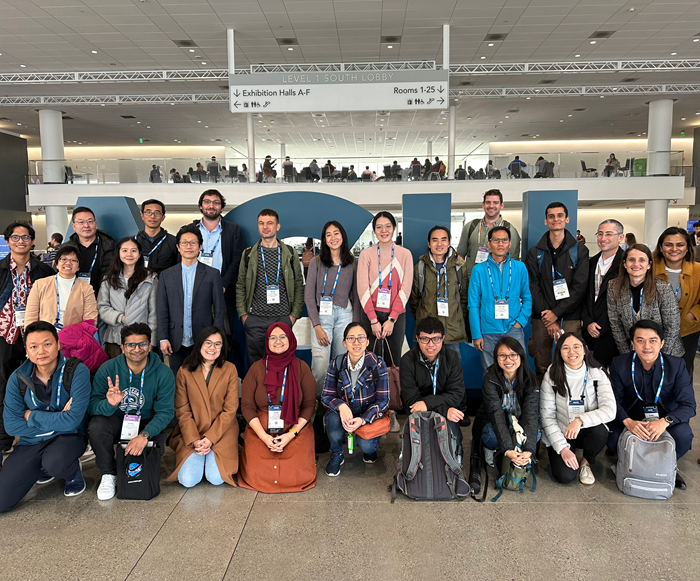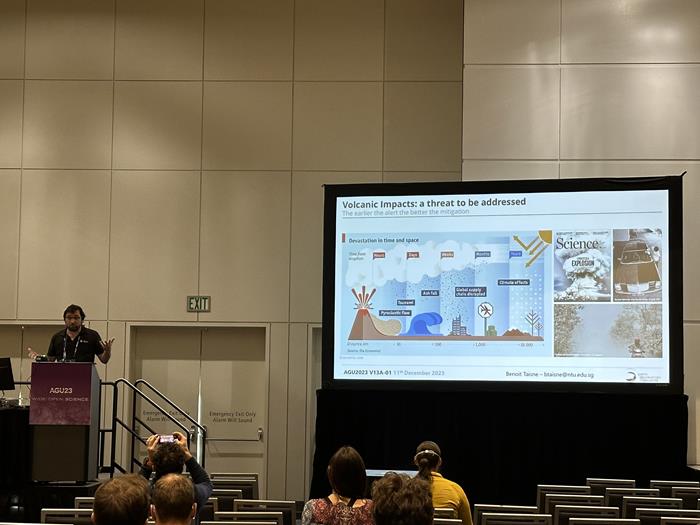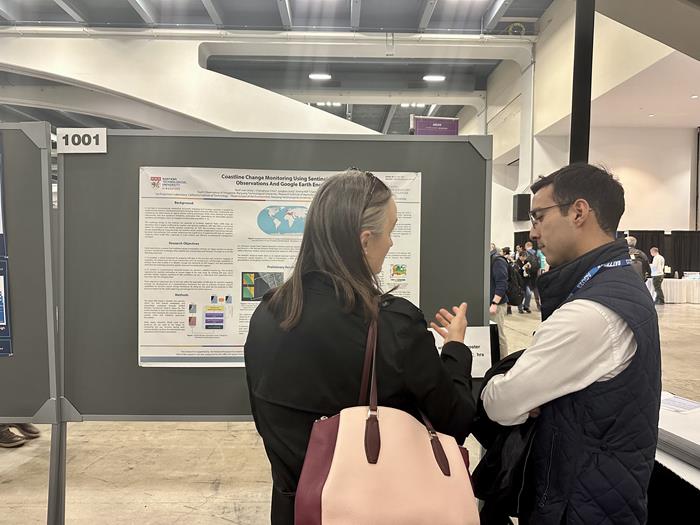Once again, representatives from the Earth Observatory of Singapore (EOS) were back at the American Geophysical Union (AGU) Annual Meeting, which was held, this year, in San Francisco. 38 EOS scientists and staff presented their research and engaged with other participants to develop collaborations and advance research in geohazards and climate change.

Some of the EOS scientists who attended the AGU Annual Meeting 2023 (Source: Earth Observatory of Singapore)
“A few large conferences about the geosciences and earth systems are rotating in space and time, such as AGU, EGU and AOGS. They give a unique opportunity to learn and present about our research area,” said Associate Professor Benoit Taisne, a Principal Investigator at EOS who leads the Magma Transport Dynamics team. “By being broader than topical workshop, they offer the possibility to keep our mind sharp and aware of progress in other fields, which could lead to unexpected collaborations and scientific breakthrough,“ he added.

Associate Professor Benoit Taisne presented a new platform to assess volcano hazard from monitoring data (Source: Earth Observatory of Singapore)
“The AGU conference is the biggest conference in geoscience, and it brings together the most innovative minds in the field, promoting an environment of collaboration and knowledge-sharing,” said Dr Noel Ivan Ulloa, a Research Fellow part of the EOS Remote Sensing Lab. “AGU offers a unique opportunity to connect with peers and stay updated of cutting-edge research, which I hope will be helpful in advancing my work.”

Dr Noel Ivan Ulloa presented a poster about monitoring coastline change using remote sensing (Source: Earth Observatory of Singapore)
In such big events, there is indeed something for everybody. “For professors, they offer the opportunity to identify rising talent in the field, and for students, they provide a unique opportunity to shine and build a professional network to help them grow in the future,” said Assoc Prof Taisne.
EOS had a booth in the exhibition hall throughout the event, and received about 500 visitors who were curious to learn about EOS’ new programmes, such as the Integrating Volcano and Earthquake Science and Technology (InVEST) in Southeast Asia and the Climate Transformation Programme (CTP) led by the Earth Observatory of Singapore. InVEST, which is led by Professor Emma Hill, aims to provide the essential predictive and quantitative understanding of geohazards in Southeast Asia to reduce risk and impacts and to save lives and infrastructure. The other programme, CTP, aims to develop, inspire and accelerate knowledge-based solutions and educate future leaders to establish the stable climate and environment necessary for resilient, just, and sustainable Southeast Asian societies. These two main programmes gather large interdisciplinary teams and are looking for new talents. Many visitors to the EOS booth were interested in the career opportunities these two programmes have to offer.
 Members of the EOS Community Engagement and Advancement teams engaged with more than 500 participants at the EOS booth (Source: Earth Observatory of Singapore)
Members of the EOS Community Engagement and Advancement teams engaged with more than 500 participants at the EOS booth (Source: Earth Observatory of Singapore)
More than half of the EOS scientists who joined AGU23 were early careers who presented their latest findings, and got feedback on their research. “Participating in AGU23 allowed me to expand my knowledge, establish networking opportunities, and gain valuable perspectives on the latest developments and innovations in my expertise,” said Dr Abang Nugraha, a Research Fellow at EOS working with the
Coastal Lab. “It also gave me the opportunity to showcase our ongoing projects to my peers.” This resonated with many other participants, such as Gina Sarkawi, a Research Assistant in the EOS
Geodesy Group. "AGU offered me the opportunity to get feedback on my research from a variety of expert scientists from around the world. I got to reconnect with collaborators and discuss new research opportunities," she added.
 Gina Sarkawi presented a poster on past ruptures along the Sunda Megathrust (Source: Earth Observatory of Singapore)
Gina Sarkawi presented a poster on past ruptures along the Sunda Megathrust (Source: Earth Observatory of Singapore)
Another valuable aspect of AGU is that it allows scientists to reconnect with former colleagues and make new connections. “This is my first AGU in eight years, it was so great to be back,” said
Assistant Professor Lujia Feng, the newest EOS PI. “I enjoyed both the social and science aspects of the meeting. I re-connected with so many of my old friends, and got to meet lots of new friends too.” Bringing old and new friends together was also the goal of the traditional reception that EOS organised on one of the evenings.
 Assistant Professor Lujia Feng presented a poster on the 2022-2023 M6-7 Siberut earthquake sequence (Source: Earth Observatory of Singapore)
Assistant Professor Lujia Feng presented a poster on the 2022-2023 M6-7 Siberut earthquake sequence (Source: Earth Observatory of Singapore)
AGU remains one of the main conferences attended by EOS scientists, thanks to its interdisciplinary nature and its reputation which brings thousands of scientists from around the world. Discovering new research findings, discussing about existing and new projects, and forging long-lasting collaborations are crucial to EOS research to advance knowledge of geohazards and climate change in Southeast Asia.